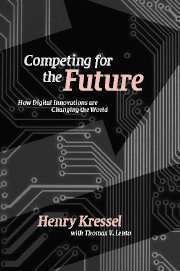Book contents
- Frontmatter
- Contents
- List of figures
- List of tables
- Acknowledgements
- Introduction
- Part I The technology – how electronic devices work – digital systems and software
- Part II Innovators, entrepreneurs, and venture capitalists
- Part III Global reach, global repercussions
- Appendix 1.1 Smaller, faster, more efficient MOSFETs
- Appendix 1.2 Building multi-transistor logic gates
- Appendix 1.3 MOSFETs in memory devices
- Appendix 1.4 CMOS reduces logic gate power dissipation
- Appendix 1.5 Laser diode basics
- Appendix 1.6 Light-emitting diodes (LEDs)
- Appendix 1.7 Photodetectors
- Appendix 1.8 Making fiber optic cables
- Appendix 1.9 Principles of LCD displays
- Appendix 2.1 The demise of analog computers
- Appendix 2.2 IP, TCP, and the Internet
- Appendix 2.3 Building an object-oriented program
- Index
Appendix 1.3 - MOSFETs in memory devices
Published online by Cambridge University Press: 07 December 2009
- Frontmatter
- Contents
- List of figures
- List of tables
- Acknowledgements
- Introduction
- Part I The technology – how electronic devices work – digital systems and software
- Part II Innovators, entrepreneurs, and venture capitalists
- Part III Global reach, global repercussions
- Appendix 1.1 Smaller, faster, more efficient MOSFETs
- Appendix 1.2 Building multi-transistor logic gates
- Appendix 1.3 MOSFETs in memory devices
- Appendix 1.4 CMOS reduces logic gate power dissipation
- Appendix 1.5 Laser diode basics
- Appendix 1.6 Light-emitting diodes (LEDs)
- Appendix 1.7 Photodetectors
- Appendix 1.8 Making fiber optic cables
- Appendix 1.9 Principles of LCD displays
- Appendix 2.1 The demise of analog computers
- Appendix 2.2 IP, TCP, and the Internet
- Appendix 2.3 Building an object-oriented program
- Index
Summary
An important application of multi-transistor gates is the creation of building blocks that retain information, enabling data storage devices.
The static random access memory (SRAM) requires six transistors per storage cell. The electrical configuration of the “unit” determines whether a bit is stored there or not. The MOSFET structures used in SRAMs are fairly standard and comparable to those used in building logic elements.
However, special structures are used to build the dynamic random access memory (DRAM), which stores a charge on individual transistors that incorporate a capacitor. This charge must be constantly refreshed in millisecond cycles as it leaks away.
At the other end of charge storage technology is FLASH (non-volatile) memory, which will maintain charge in the complete absence of a power supply. It requires special MOSFET structures very different from the standard devices.
These MOSFETs hold an electrical charge for a very long period of time in a special isolated capacitor.
Figure A-1.3.1 shows a highly simplified schematic of a special MOSFET p-channel transistor. In contrast to a standard MOSFET, it has a silicon film imbedded within an insulating silicon dioxide film sitting on top of where the gate would normally be. This constitutes the “floating” gate of the p-channel MOSFET.
The basic operation by which the cell stores one bit is as follows.
The device is programmed by injecting an electronic charge into the floating silicon gate (by applying a very short high-voltage pulse).
This negative charge in the silicon film – the “floating gate” – induces a conducting p-type channel between the two p-type regions, turning it on.
[…]
- Type
- Chapter
- Information
- Competing for the FutureHow Digital Innovations are Changing the World, pp. 357 - 358Publisher: Cambridge University PressPrint publication year: 2007



